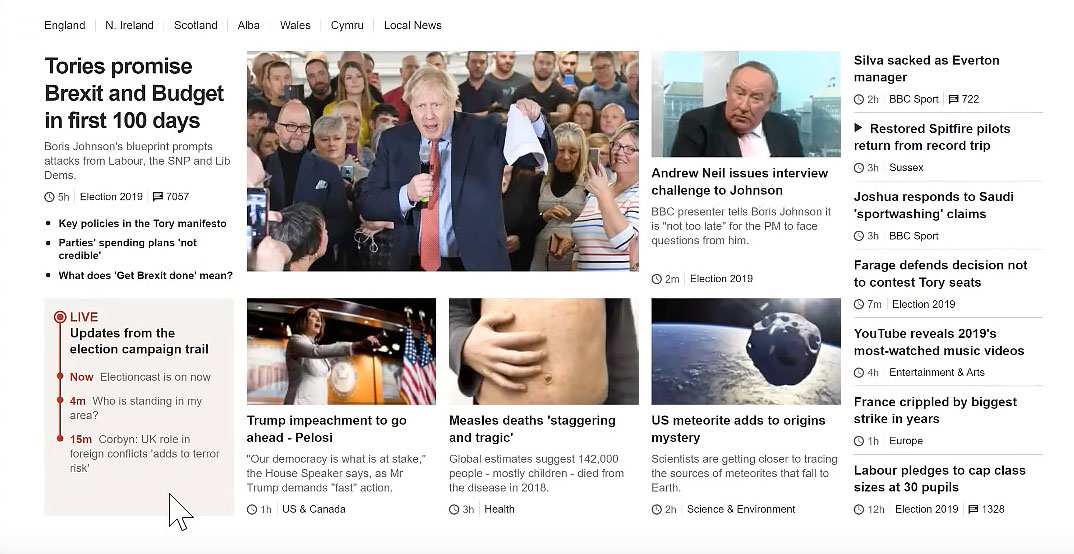Grid / Flex Box Quiz
Instructions
This exersize will work with CSS flexbox and CSS grids. There are similarities between the two. Flexbox has one dimension in either direction, x or y axis, and grid does both x and y axis.
View Rachel Andrews video as she creates a layout, to get an overall idea of how to develop a layout using grids to do a layout from scratch. She copies a BBC page that is more complicated than what you will run into but following her is rewarding. Watch the first 45 minutes.
Setting up the grid.
- Changing the display of an element from block to grid is all it takes to turn the direct children of the element into grid items.
- Target section and turn display to grid, add grid-template-rows at 1fr and give the section padding: 0 10px.
- Assuming that the grid takes up most if not all of the page, it will need to be responsive to gracefully end up with one column for a smartphone and more for larger screens.
- create a media query that puts the smartphone in the default position and the larger screen in the media query box using @media all and (min-width: 600px) {}
- Most of the CSS will target the full screen version in the @media box. Check to see whether the CSS I ask you to target is for the smartphone and place the rules in the default position, or the large screen, and place the rules in the media query box. I will indicate where I want you to put the CSS rule.
- Set up the page for viewing on smartphones.
- In the head set the viewport to the device screen size and force zoom to be 1:1 < meta name="viewport" content="width=device-width, initial-scale=1, maximum-scale=1">
- Put a border on the children so you can see them. Don't forget to style the border solid. Targeting the direct children requires > as in section>*. Using the universal selector here selects all the children.
- For the smartphone create a 3px solid purple border on the bottom and 10px of padding. {border-bottom: 3px solid purple; padding: 10px;}
- For larger screens create a full 1px purple border.
- Target images and set width to 100%;
Navigation flex box.
- Target the navigation links and set text-decoration to none, background to red, text color to white, padding 10px top and bottom, 20px left and right. margin 2px and display as block.
- Set the hover background to green.
- Remove list-style from navigation list items. Set it to none.
- The menu has to go inline for the large screen. There are a number of ways to do this. Traditionally it was done using display: inline-block or float. The flex-box option is the best.
- For the wide screen, turn the unordered list in the navigation element to display: flex and justify-content: center.
- Turn the nav list items to flex-grow 1 for wide screen. That should spread out the links to the width of the parent element.
Styling the grid in widescreen
- Target the wide screen grid divisions. grid-template-columns: 1fr 1fr 1fr;
- Span grid cells in header and footer. header, footer {grid-column: 1 / span 3;}
- Span id instructions to cover two rows. #instructions {grid-column: 2 / span 2;}
Video and Grid Resources

- Watch the first 45 minutes of Rachel Andrew as she works her way through a layout from scratch
- Didn’t get enough? See Rachel Andrew go through another demonstration? Build a responsive website in under an hour and talks her way through with all the detail that will help you understand the how and why of building your site using grid layout.
- Check out her new series on Understanding Grid at Smashing Magazine, Creating a Grid Container, Grid lines and grid template areas.
- Resilient Web Design A great book if you are one of those people who wants to know more about the nature of the web by one of its pioneers.
Finishing Up
- Target every odd list item in the articles with background color azure. :nth-child(odd). Color the even ones lightyellow.
- target ids empty and finishing, set to flex and color background azure.
Flex Box Articles
Learn more about flexbox by reading these articles written by Rachel Andrews.